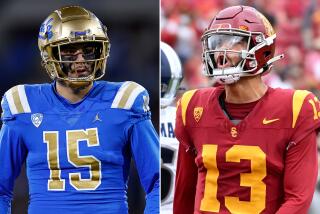Parents stand up and cheer as a $15 sneaker enters the game
Waiting in a winding line for autographs from his favorite NBA player, 15-year-old Brian Cox lifted the lid of a shoebox to show off his synthetic leather high-top sneakers with black sides and blue-and-orange soles.
At a price his mother doesn’t mind -- $14.98 -- he got his fourth pair of Starburys this week, a sneaker created by New York Knicks point guard Stephon Marbury. Joanne Cox brought her two teenage sons to Steve & Barry’s University Sportswear after church Sunday for the launch of Marbury’s spring line.
The NBA star “grew up in a poor neighborhood just like we did,” said Cox, who is raising the boys on her own. She says it is not easy on the wages she earns as a city traffic officer, and she has spent thousands on her sons’ shoes over the years. “Now that we got a price of $15, we’re not going higher than that.”
This is the world the 10-year NBA veteran is trying to change with his $15 shoes -- a world where parents are pressured to shell out money for expensive sneakers while struggling to pay rent and buy groceries; a world where kids get robbed, shot and strangled over the latest styles. (In January, 10 Detroit middle school students were robbed of their Nike boots and Air Force One sneakers at gunpoint.)
Marbury knows it will take a while to pull off a Michael Jordan impact at a Wal-Mart price. So far, he says, he’s willing to do it one sneaker-crazed teen at a time. Starburys have been holding their own in schools and on basketball courts alongside kicks that cost 10 times as much.
Marbury is so confident of the sturdiness of his shoes that he is wearing them on the court this season. He says his pair is straight off the shelf, with no alterations or enhancements. Chicago Bulls center and four-time NBA Defensive Player of the Year Ben Wallace has also partnered with Steve & Barry’s to release his own inexpensive sneaker -- Big Ben -- in late August or fall.
Still, sneaker aficionados wonder whether a $15 shoe will change a cultural phenomenon that has thrived since Jordan came out with his line in 1985. Not all kids are sold on the idea, even if the sneaker is endorsed by someone they admire.
“The theory is because an NBA athlete is playing in the shoe, it’s a perfect shoe,” said Matt Powell, a senior retail analyst with SportsOneSource, a data and research firm for sporting goods. “I could go out and play basketball in a pair of flip-flops, but that doesn’t make them a perfect shoe.”
Powell, who has examined the Starbury Ones, said they don’t have the same cushioning, ankle-support or durable soles as high-priced sneakers. He said they are comparable to sneakers found at Payless ShoeSource or Target.
But T.J. Gray, a designer for Rocketfish, the firm hired to design the Starbury line, said the sneakers are about the same as high-end basketball shoes. “We’re building them with the same construction, we’re using similar materials,” said Gray, who has also designed shoes for Nike, Reebok, Puma and Converse.
The Starbury II sneakers unveiled Sunday have better arch and heel support than the first version. The side of the shoe features an emblem that combines the letter M; Marbury’s jersey number, 3; and a star. They come in six low-top colors and eight high-top colors, including one style for girls.
The popularity of sneakers has soared in recent years with people hunting for the latest styles on the Internet, said Bradley Carbone, associate editor of Complex magazine, which targets young men. Companies allow customers to design sneakers online. Exclusive boutiques sell limited-edition pairs, like the Slim Shady Nikes, endorsed by Eminem, which have retailed for $800. But Marbury’s idea, Carbone added, is smart because it targets a different, often forgotten, consumer.
“You’re not going to lure your big Nike heads and collectors,” he said, “but you will reach people who aspire to that.”
Tearful grandmothers
Marbury, 30, grew up wanting Air Jordans like every other kid, hoping for a pair on every birthday and Easter. He never got them.
“Kids don’t understand that their parents can’t spend $200 on a pair of sneakers when you got light and utility bills,” Marbury said. “When you live in the ghetto and you don’t have any money to buy your child something they want, that frustrates parents.”
One of seven siblings, he lived in Coney Island’s Surfside Gardens housing project, a cluster of 15-story beige brick complexes broken up by basketball courts, including one nicknamed “The Garden,” after Madison Square Garden. The neighborhood is a 25-minute walk from the last subway stop in Brooklyn. Along the way, carcasses of old sneakers dangle from utility lines.
Marbury’s family lived in a fourth-floor apartment with no identifying number. For him, life could not have felt farther away from the roller coasters and sideshows that made Coney Island famous. Sneakers and basketball -- that’s what it was all about for kids in his neighborhood. Marbury became a two-time NBA All-Star. Coney Island shop owners posted his picture in their stores. But going home brought memories of his parents’ hardships. He thought about how big a deal it was when they saved to buy him a leather jacket when he was 13.
He teamed up with Steve & Barry’s University Sportswear, which worked on his idea of creating a quality and affordable sneaker. Designers pitched ideas, and Marbury offered his critiques until they got it right. To keep costs low, the company produced the shoes on its own and sold them exclusively in their 193 stores, including nine in California. When the shoe was released in August, the store relied on word-of-mouth instead of big marketing campaigns.
“We ordered more Starburys than most sneaker companies sell in a whole year to fill the holiday season,” said Andy Todd, president of Steve & Barry’s, “and we sold through most of them.”
Marbury, who turned down a signing bonus for the shoe deal and makes money only off the sales, said mothers and grandmothers have thanked him with tears in their eyes.
“There will be more people wearing the Starburys than wearing the other sneakers,” Marbury said. “They will only get better over time.”
‘That’s too cheap’
For some kids, a $15 shoe will never be cool.
In Marbury’s old neighborhood, 13-year-old Jahmal Benu played basketball with friends on a windy Coney Island court. He was wearing old-style Jordans. A $15 shoe? “That’s too cheap,” he said.
His friend, Damien Collier, 13, nodded. Damien wore $70 green, white and orange Nikes with fat yellow laces and a collared shirt that matched every color in his shoes.
“People will make fun of you,” Collier said, “if you got cheap kicks on.”
Jahmal has a sneaker budget of $200 a month -- about the cost of what his mother, a nurse, pays in rent. Benu made a deal with his 24-year-old sister: He’ll keep up his grades as long as she finances his shoes.
Malika Augustin, who works as an assistant in a law office, said she agreed to help her brother because she remembered kids taunting her when her family could not afford the latest trends. She researched Starburys online, wondering if her brother would be interested. “Fifteen dollars, that’s a good price,” Augustin said. “I can never find a low-priced pair.”
But Jahmal said Starburys were not on his list.
“The lowest she gives me is $65 for sneakers. That’s the lowest,” he said, bouncing a ball on a frigid afternoon. Starburys, he added, “I would never get them.”
*
More to Read
Get our high school sports newsletter
Prep Rally is devoted to the SoCal high school sports experience, bringing you scores, stories and a behind-the-scenes look at what makes prep sports so popular.
You may occasionally receive promotional content from the Los Angeles Times.






